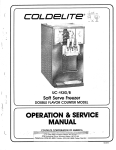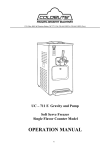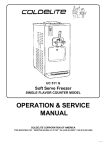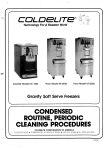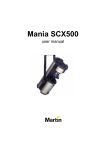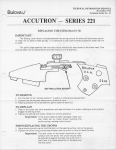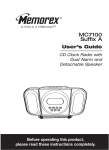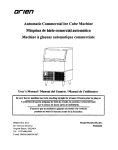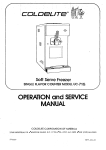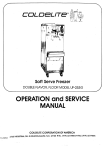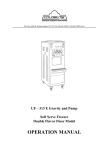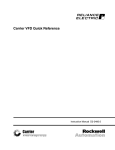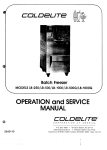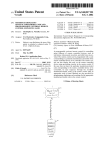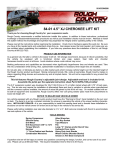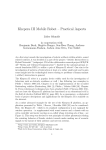Download OPERATION & SERVICE MANUAL
Transcript
Soft Serve Freezer DOUBLE FLAVOR COUNTER MODEL OPERATION & SERVICE MANUAL COLDELITE CORPORATION OF AMERICA 3760 INDUSTRIAL DR. * WINSTON-SALEM, N.C.27105 * TEL.(910) 661-9893 * FAX (910) 661-9895 File: 820-1.pm5 Ed. 02/98 FOREWORD Thank you for selecting COLDELITE to meet today's fast growing demands. Your COLDELITE freezer has been manufactured at one of the most modern manufacturing plants, utilizing the most advanced equipment and technology available in the industry. We at COLDELITE, take great pride and care in the manufacture of each and every freezer, using only the finest components available, to provide you with years of trouble-free operation. Over twenty-five years of experience in the manufacturing of dispensing equipment have guided us in the preparation of this Operation and Service Manual. PLEASE READ IT CAREFULLY. Keep it for future reference and most of all, follow the instructions from the very time your machine is put into service. On the following pages, you will find important information and procedures which describe the proper installation, sanitizing, operation, and maintenance of your COLDELITE machine. We feel certain that your full compliance with these instructions will assure you of excellent performance, trouble-free operation and profitable business for years to come. All fechnical dafa, pictures and drawings contained in this manual are not binding on the manufacfurer, nor can the manufacfurer be held liable for any modification of the machine in part or complefely. CODE: ...... ........ File: 820-1.pm5 Ed. 02198 INDEX FOREWORD ..........................................................................................3 PART I .INSTALLATION .....................................................................5 A) B) C) D) E) F) UNCRATING ............................................................................................... 5 POSITIONING THE MACHINE ...................................................................... 5 MACHINE EQUIPPED WITH AIR COOLED CONDENSER .......................... 6 MACHINE EQUIPPED WITH WATER COOLED CONDENSER ................... 6 WATER VALVE ADJUSTMENT ..................................................................... 6 ELECTRICAL REQUIREMENTS ................................................................... 7 CONTROL PANELS ....................................................................................... 7 ELECTRICAL CONNECTIONS ...................................................................... 8 BEATER ROTATION ...................................................................................... 8 COMPLETING THE INSTALLATION ............................................................. 8 PART II .EXPLANATION OF CONTROLS .............................................. 9 A) B) C) D) E) F) ELECTRONIC CONTROL PANELS ............................................................... 9 THE DISPENSE HANDLES ......................................................................... 11 PROXIMITY SWITCHES .............................................................................. 11 ADJUSTING PROXIMITY SWITCHES ........................................................ 11 SAFETY SWITCH ........................................................................................ 12 ELECTRIC CONTROL PANEL .................................................................... 12 OTHER CONTROLS .................................................................................... 12 PART Ill .INITIAL CLEANING PROCEDURE ....................................... 13 A) B) C) D) CLEANING PROCEDURE ........................................................................... DESMOUNTING DISPENSING HEADS ...................................................... DESMOUNTING BEATER AUGER ............................................................. CLEANING OPERATIONS ........................................................................... 13 15 17 18 PART IV .ASSEMBLING THE FREEZER ............................................. 19 A) C) ASSEMBLING THE BEATER ....................................................................... 19 MIX PUMP ASSEMBLING ........................................................................... 24 PART V .SANITIZING THE FREEZER .................................................. 25 PART VI .STARTING THE FREEZER ................................................... 27 HOM ADJUSTMENT (AUTOMATIC) ..................................................................... 28 PART VII .OPERATING THE FREEZER ............................................... 29 A) B) C) STAND BY .................................................................................................... 29 CONE COUNTER ........................................................................................ 29 ADJUSTING THE PUMP FOR OVERRUN .................................................. 30 PART Vlll .ROUTINE. PERIODIC CLEANING PROCEDURES ............ 30 PART IX .TECHNICAL INFORMATION ............................................ 32 A) B) C) COMPRESSOR MOTOR ............................................................................. 32 BEATER MOTOR .SINGLE PHASE ........................................................... 32 OVERLOAD .................................................................................................. 32 PART X .MAINTENANCE ....................................................................32 A) B) File: 820- 1.pm5 Ed . 02/98 TROUBLE SHOOTING GUIDE .................................................................... 33 ALARMS ....................................................................................................... 35 IMPORTANT! Failure to closely follow operational and maintenance procedures may result in damage to the unit andlor void your warranty. Coldelite Corporation will not be responsible for any machine not properly maintained. In the event this unit should malfunction, please contact your Coldelite Distributor or an authorized service agency. PART I INSTALLATION B) POSITIONING THE MACHINE 1) The freezer is equipped with four pivoting wheels to allow easy location. When the freezer is placed in the desired location, it must stand level. Check for level condition by placing level on the top of the freezer at each corner. Lock wheels to prevent freezer sudden movements. NOTE: Accurate leveling is necessary for correct drainage of freezer barrel and to insure correct over-run. Before starting this procedure, make sure the shipping case does not show any evidence of having been dropped, tampered with or abused in such a way as to indicate that its contents may have been damaged in transit. IMPORTANT: Should the outside of the shipping case give any indication of possible hidden damage, state this on the bill of lading before signing. Contact the carrier immediately and request an inspection of damage. If this procedure is not adhere to, you will forfeit your right to file damage claim and be responsible for subsequent repair costs. A) UNCRATING Proceed, as follows: The case is secured to the skid with metal strapping. When you cut this strapping, do it with caution, as it may spring out. Remove case by lifting it straight up and away from the machine. The machine is also secured to the skid with metal strapping. Exercise caution and cut this strapping to free the machine from the skid. Remove the single screw at the bottom of each side panel. Remove the panels by sliding upward slightly, thenpull outward at the bottom and allow the panel to slide down. The protective plastic coating which is laminated to the panels can now be removed by simply peeling off. File: 820-1.pm5 Ed. 02/98 C) MACHINE EQUIPPED WlTH AIR COOLED CONDENSER 1) The freezer is now ready to be positioned. Machines with aircooled condenser must be installed no closer than 2 FT to any wall in order to allow free air circulation around the condenser (Ref. Fig. 1). NOTE: An insufficient air circulation affects operation and output capacity of the machine. D) MACHINE EQUIPPED WlTH WATER COOLED CONDENSER 1) If the unit is water cooled, it should be located close to the water supply and a drain within six feet. 2) Connect fitting marked "WATER IN" to the cold water supply. Connect the fitting marked "WATER OUT" to a drain (see Fig.2). NOTE: All plumbing must meet local and state codes. Fig. 2 WATER VALVE ADJUSTMENT The water valve is preset at the factory, but if an adjustment should be required, proceed as follows: To maintain a head pressure of 225-235 psi while the compressor is running, attach a refrigeration high pressure gauge to the compressor's high side discharge port, and open the water valve clockwise to increase the pressure or counter clockwise to decrease the pressure (Fig.3). NOTE: If these clearances are not maintained, the production capacity will be reduced, cycling will increase and the potential will exist that the machine will stop completely. 2) It is necessary to clean the condenser each month to eliminate dust, paper, etc. which may obstruct it, damaging the proper functioning of the machine. 3) The machine should also be within six feet of the power supply (a plug and receptacle or unfused disconnected). Fig. 3 4) Position the machine for easy accessibility for cleaning, servicing and maintenance. 5) Position the machine away from direct sunlight. For every 2°F over 68"F, the machine's performance will decrease by approximately 1%. File: 820- 1.pm5 Ed. 02/98 Never expose water cooled machines to temperature at or below 32" F. without having drained the water from the condenser. If drainage is not done properly, serious damage can occur. E) ELECTRICAL REQUIREMENTS All wiring installed to operate this freezer must be in accordance with the National Electrical Code andlor local electrical codes, rules and regulations. The machine must be properly grounded. It is recommended the power supply be installed by a licensed electrician. Voltage: Total Running Amperage FLA: Fuse Size: Wire Size (50 Ft. Max.): CONTROL PANELS NOTICE: As the machine is equipped with two control panels, check which panel signalled the alarm. To restart the freezer, depress the STOPIRESET button located on the front switch pad. The heater protection must cool down for several minutes before the RESET will operate. See Fig. 4. 2081230 Volt 38 A 32 A A WG 12x2 Power Supply must be adequate to meet requirements at all times. Voltage fluctuations, with the machine in operation, should not exceed 4 5% of the normal or rated voltage. Adequate Wiring must be provided with respect to wire size or gauge. Unless otherwise required by the local Electrical Code, the same size wire gauge at the machine junction box should be used for direct power line. A separate circuit breaker with adequate fuse protection should be employed. An unfused disconnected switch or a properly sized plug and receptacle within 6 feet of the freezer, is recommended. Coldelite freezers are equipped with protection for the beater motor. Should the line voltage drop, or in the unlikely event a short circuit occurs, the overload protector will automatically disconnect the starter and the machine will stop immediately so that no permanent damage can be caused to the motor. @ AUTOMATIC @ STAND-BY @ BEATER @ MIX LEVEL Fig. 4 File:820-1.pm5 Ed. 02/98 ELECTRICAL CONNECTIONS F) Having removed the front side panel, the machine's wiring connection box can be found on the bottom of the frame and is labelled "Connect Power Line Here". The power line is first passed through the access hole located at the bottom deck directly below the wiring connection box. The power line may then be connected to the machine's power lines and wiring connection box. Upon completion, the power line should be fastened to the wiring connection box with appropriate electrical hardware. COMPLETING THE INSTALLATION On the following pages, you will find important information and procedures which describe the proper installation, sanitizing, operation and maintenance of your COLDELITE machine. We feel certain that your full compliance with these instructions will assure you of excellent performance, trouble-free operation and a profitable business for years to come. NOTICE: Failure to closely follow set-up and maintenance procedures can void your warranty. Coldelite Corporation will not be responsible for any machine not properly maintained. In the event this unit should malfunction, please contact your Coldelite Distributor or an authorized service agency. WARNING: EXTREME CARE MUST BE TAKEN WHEN REMOVING SIDE, REAR OR CONTROL BOX PANELS. Fig.5 In all installations, the machine must be properly grounded. Since all high voltage components (controls are 24 volts) are connected by means of flexible conduit, or cord, adequate ground continuity is assured by running and fastening a ground line to the machine junction box ground lug (Fig. 5). BEATER ROTATION After electrical connections are completed, check the rotation of the beater. It should be counter clockwise when facing the front of the machine. File: 820- I .pm5 Ed. 02/98 ALWAYS TURN THE MACHINE TO THE OFF POSITION. ALSO TURN OFF THE DISCONNECT SWITCH ON ELECTRICAL SUPPLY LINE BEFORE EXPOSING ANY ELECTRICAL CONNECTIONS AND/OR MOVING PARTS, SUCH AS BELTS, PULLEYS, FAN BLADES AND BEATER. PART II EXPLANATION OF CONTROLS A) ELECTRONIC CONTROL PANELS Leds L l i L 4 Lighted function indicators These indicators illuminate to show that the function corresponding to the signal next to the indicator itself is on. Leds L5 Low level indicator This led illuminates to show the hopper is empty and you must refill it with mix. Monitor pos. 570 This numerical monitor displays the consistency of the product when the machine is operating in AUTOMATIC. STOPIRESET button pos. 571. I L2 AUTOMATIC L3 STAND-BY L4 BEATER w RESET With the StopIReset function on, pilot light pos. L1 lit, the machine is ready to receive the command for any of the main functions. SELECT button pos. 571.2 L5 MIX LEVEL THE MACHINE IS EQUIPPED WITH TWO ELECTRONIC, INDEPENDENT CONTROL PANELS HAVING THE SAME FUNCTIONS. EACH PANEL CONTROLS ONE SIDE OF THE MACHINE. By pushing this button you can select the functions: -Automatic -Stand-by -Beater Indicators illuminate to shown that the function corresponding to the signal next to the indicator itself is on. File: 820-1.pm5 Ed. 02198 AUTOMATIC ~5 AUTOMATIC I Automatic function Hopper Mix level indicator When this function is on, pilot light pos. L2 lit, the mix is This pilot light pos. L5 indicates that the level of the mixin cooled down until it reaches the proper consistency (pre-set the hopper has reached the minimum allowed, and that HOT setting). more mix must be added. During this function, the Monitor displays a number indicating A buzzer will be on when light is on. the consistency of the product in the cylinder until it reaches the set value, then it indicates the temperature of the mix in When illuminated, dispensing of product should be stopped the hopper tank. and the tank refilled with mix. Each tank has a total capacity of 32 qts each when full. The MIX LEVEL SENSOR is located in the hopper of each mix tank (see Fig.7). STAND-BY Stand-by function This position is used during prolonged idle periods. The temperature of the product in both the mix hoppers and freezer cylinder is held at a safe temperature and controlled automatically by the temperature probes. Product should never be served when in this position, as the "storage" temperature is higher than normal serving temperatures. When this function is on, pilot light pos. L3 lit. When pushing this button, the beater motor and the cooling motor are ON until the product temperature reaches the programmed temperature. If the machine runs in stand-by mode for a prolonged period, the product temperature is kept constant automatically. In such condition, the cooling motor is ON whereas the beater motor is OFF. ~4 BEATER I Beater function With this function on, pilot light pos. L4 on, only the beater turns. This function is timed and ends automatically when the set time is over (about 15 minutes). File: 820- 1.pm5 Ed. 02/98 Mix level sensors B) THE DISPENSE HANDLES The Dispense Handles control the flow, or extraction rate of finished, soft serve product. The left handle serves a flavour of product, the right one serves a different flavour whereas the midle one dispenses a mix of the two. Pulling one of the handle in a downward direction will open the corresponding dispense orifice. When the unit is in the "AUTOMA TIC" mode, this will allow finished product to be extracted and served. C) PROXIMITY SWITCHES In AUTOMATIC function, the proximity switches pos. 152 start the beater motors when the hand, handling cup or cone, is in the range of the sensitivity preset by Coldelite. Note: Keep the sensors always clear and clean. ADJUSTING PROXIMITY SWITCHES The proximity switches pos. 920 (Fig.9) have been preset at the factory and their range is 9-14 inches approx. If modification is required, contact authorized service agency as this operation must be carried out by specialized technicians. File:820-1 .pm5 Ed. 02/98 D) SAFETY SWITCH Machine is equipped with a magnet molded into the spigot head. If the spigot head is removed the magnet deactivates a safety switch behind the front panel. The machine will not operate with the spigot head removed. Alarm AL9 will appear on the display. E) ELECTRIC CONTROL PANEL The Electric Control Panel located behind the bottom front panel of the unit, contains the controlling circuit to the components of the machine. This panel is to be accessed only by trained, experienced technicians. A Warning /i\ Disconnect freezer from the source of electrical supply before attempting to service. F) OTHER CONTROLS 1) Refrigeration SOLENOID VALVES are located behind the left side panel. These valves are normally closed and when energized by the electronic board, direct refrigerant flow to either the freezing cylinder or mix tank. The mix tank solenoid is identified as "EVV and the cylinder solenoid as "EVC". 2) The HIGH PRESSURE SWITCH. In the event of high pressure situation, it will shut down the compressor. Reset is automatic when the high pressure subsides. Common causes for cut-out or shut down arerestricted air flow on air cooled models, unusually high ambient (room) temperatures, and restricted or excessively hot water flow on water cooled models. File: 820- 1.pm5 Ed. 02/98 PART Ill INITIAL CLEANING PROCEDURE A Warning /j\ A) CLEANING PROCEDURE 1) Proceed with the disassembly process by extracting connection pipe from the pump (Fig.10). Slightly turn pressure pipe and extract it from its seat. Connection During all following operations unplug the machine so as to cut it out. This is a new machine and it must be completely disassembled, washed, and sanitized before starting. Proceed, as follows: - Remove the mix tank cover and items packed in the tank (spare parts, sanitizer, lubricant). The spare parts or start-up kit will include: 1) 2) 3) 4) 5) 6) a spatula spare o-rings and rubber seals an o-ring extractor a tube of sanitary lubricant three various sized cleaning brushes several packets of sanitizer and the OPERATIONAL MANUAL. HELPFUL SUGGESTION: Before proceeding with the disassembly of the freezer, we recommend a plastic dish pan be used in which to place the parts. This will minimize the possibility of misplacing or damaging the various component parts. 2) Turn the pump slightly and extract it from its seat (Fig.1 I ) . 3) Clean carefully the mix level sensor (Fig.1 I ) . File: 820-2.pm5 Ed. 02198 4) Remove all pump components as shown in the picture below. File: 820-2.pm5 Ed. 02/98 B) DESMOUNTING DISPENSING HEADS 3) Disassemble the dispensing head by first opening all the dispense handles. 1) Loosen and remove the six (6) dispensing head retaining knobs. The knobs are removed by turning in a counterclockwise direction. 4) Pull the handle retaining rod out far enough to allow the first handle to disengage. 2) Remove the dispensing head by pulling it straight towardsyou and away from the machine. 5) Return the retaining rod to its original position. Using the rod as a fulcrum, lever the dispense piston out of the dispense head with the handle. Repeat this process for each piston. File:820-2.pm5 Ed. 02198 6) Using the O-RING EXTRACTOR, remove the piston o-rings. Each piston o-ring groove is notched for easy insertion of the o-ring extractor. Now the dispensing heads is completely dismounted (see Fig.19A) Dispensing heads parts: A) B) C) D) E) F) G) H) I) 7) Turn the dispensing head over and remove the two large o-rings from the back of the head. File:820-2.pm5 Ed. 02/98 two (2), 4" diameter O-ring the dispensing head body the center piston O-ring four (4), 13/,., diameter end piston O-rings center piston two (2) end pistons handle retaining rod three (3) dispense handles one (1) handle retaining rod O-ring C) DESMOUNTING BEATER AUGER 1) Remove the beaterlaugers from the freezer cylinders. 4) Continue disassembly by removing the beater IDLER. Pull forward until the grooved portion of the shaft lines up with the opening at the front of the beater1 auger. 2) Pull the beaters STRAIGHT out towards you. Should they became jammed, DO NOT FORCE. Tap the front of the beater back into the cylinder with the palm of your hand. 5) Finally, remove the beaterlauger END PUSHER by pulling straight and away from the beater. Dismount the scraper by pulling it away from its housings. Disassemble the beaterlaugers by first removing the beater stuffing box (lip) seal, simply slide it off the shaft. Stuffing box The machine is now completely disassembled. The parts should now be washed, rinsed and sanitized. File: 820-2.pm5 Ed. 02/98 D) CLEANING OPERATIONS 1) Wash all the parts in lukewarm water (80-85" F) using a mild detergent and the cleaning brushes provided in the START-UP KIT. DO NOT USE HOT WATER ON ANY OF THE PLASTIC PARTS AS DAMAGE TO THE PARTS CAN RESULT. 2) Rinse the parts in luke warm water (80-85" F). 3) Place the parts in luke warm, sanitized water for 2 to 5 minutes. Use the sanitizer provided in the START-UP KIT following the manufacturers directions. 4) Place the parts on a clean, sanitized counter area and allow to air dry or disassemble wet. DO NOT TOWEL DRY OR RINSE SANITIZED PARTS. 4) Air Dry File:820-2.pm5 Ed. 02/98 PART IV ASSEMBLING THE FREEZER 2) Mount the rubber seal onto the scraper by keeping the head opposite to the groove. Once the parts have been washed, rinsed and sanitized, the freezer is ready to be re-assembled. Prior to beginning the re-assembly procedure, sanitize your hands by submerging in the sanitizing solution. Begin to re-assemble as follows: A) ASSEMBLING THE BEATER 1) First, re-assemble the beaterlauger assembly. Begin by gathering the five parts needed to complete each assembly: A) B) C) D) E) F) Plastic end pusher Beater Idler Beater stuffing box Blade Rubber spacer 0 Fig.26 3) Insert the scraper into the beater pins. 4) Fasten the end pusher. When installed correctly, the scraper should move freely up and down, but should not come out away from its seat. 5) Mount the idler back. File: 820-2.pm5 Ed. 02/98 6) When installed correctly, the idler (when turned) should rotate freely. If the idler does not rotate, it is incorrectly installed and must not be installed into the machine. Repeat the above instructions. 7) Next, lubricate and install the beater stuffing box1 by first lubricating the beater shaft with the lubricant included in the START-UP KIT. Place three, 114" beads in equal distances around the shaft as shown below. 11) Finally, insert the beaterlauger into the freezer cylinder. Holding the beaterlauger horizontally, slide it straight into the cylinder until it can go no further. Rotate the beaterlauger until you feel the drive shaft engage and push the beaterlauger further back to properly seat. IMPORTANT: Before installing the beaterlauger, make certain the beater lip seal is in place and the idler is properly installed. 8) Slide the rubber, beater lip seal onto the shaft. 12) Insert the second beaterlauger. Once installed, make certain the flat portion of the idler is in a vertical position. The idlers should spin freely. ' 9) Lubricate the end of the beater lip seal which is not lubricated by placing three, 114" beads in equal distances around the seal surface as shown below. 10) Repeat the above procedure for the second beater assembly. File: 820-2.pm5 Ed. 02/98 B) Assembling the dispensing head 1) Begin by gathering the parts necessary to assemble the dispensing head. These parts include: two (2), 4" diameter O-rings the dispensing head body the center piston O-ring four (4), 13/,,, diameter end piston O-rings center piston two (2) end pistons G) handle retaining rod H) three (3) dispense handles I) one (1) handle retaining rod O-ring A) B) C) D) E) F) File:820-3.pm5 Ed. 02/98 2) First, remount the end piston O-rings onto the end pistons. Simply roll onto the piston until they drop into the O-ring notches. 5) Spread the lubricant on the surface area between the two O-rings and the O-rings as well. This will ensure free movement of the dispense handles once the head is completely assembled. 3) Remount the center piston O-ring onto the center piston. This O-ring and piston are easily identified as they appear to be two O-rings grooves interconnected by two vertical posts. 5) Insert the two end pistons into the two end chambers of the dispensing head body making certain to align the square notch of the piston with the rectangular notch at the front of the dispense head. Repeat this process with center piston and center chamber. Fig.35 4) Once the O-rings have been mounted, liberally lubricate the area between the two O-rings. Place a bead of lubricant around the entire piston as shown. File: 820-3.pm5 Ed. 02/98 Fig.38 6) Turn the dispense head over and install the two 4" diameter O-rings into O-ring grooves located in the back of the head. Lightly lubricate the O-rings with the sanitary lubricant. 7) Affix the dispensing head to the machine and fasten it onto the six mounting studs. 8) Fasten the dispense head to the machine using the six (6) stainless steel retaining knobs. 9) HAND TIGHTEN the knobs in a criss-cross manner as shown below. File: 820-3.pm5 Ed. 02/98 C) MIX PUMP ASSEMBLING Grease all gaskets before placing them to their positions. Take pump body pos. 1 and grease gear seats. Assemble gears pos. 414A and OR gaskets pos. 2 and also lubricate pump surface. Assemble cover pos. 3, clamp the pumps with knobs pos. 5 and OR gasket pos. 6. Place valve pos. 7 and spring pos. 8 in their seats. OR gaskets pos. 9 must be assembled onto the regulator pos. 10 before placing the latter into pump cover. Turn the regulator by 45" C at least, in order to secure it to the proper lock position. Assemble OR gasket pos. 11 onto the connection pipe pos. 12. Assemble OR gasket pos. 13 on pressure pipe pos. 14 or 15. 10) Last reassemble seal valve pos. 16 and pos. 17 File:820-3.pm5 Ed. 02/98 A wrong or not fully proper assembling of the individual components prevents the pump from sucking as sufficient quantity of mix from the tank, so damaging the beater. The pump may not operate if spring and valve acting as safety devices against overpressures have been removed from the regulator. PART V SANITIZING THE FREEZER Prior to install the machine with your soft serve product, the machine must be sanitized. The frequency of cleaning and sanitizing cycles must comply with local health regulations. If uncertain about local regulations, contact your local Board of Health. Sanitizing the machine is most important. This procedure will retard the growth of bacteria and insure excellent test results on your product when examined by local Health andlor Agriculture Departments. To begin, you will need a clean pail, sanitizer (sample packets included in the start-up kit), spatula (included in start-up kit), and brush (plastic bristle). 2) Push selector button 571.2 PUSH TOI II SELECT I to select the BEATER position. I B BEATER 3) Let the machine run for 30 seconds. This will allow the cylinder and the pump to be completely filled with the sanitizing solution. 4) Push selector button 571. I "OFF" the machine. 5) Using a sanitized soft bristle brush, brush the sides of the mix tank, and all other product contact areas. Allow the sanitizing solution to remain in contact with all product contact areas for three to five minutes. 1) Mix the sanitizer (2 ounces of Steera Sheen green label or equivalent) into a clean pail containing two gallons of warm water. This solution will make a 200 P.P.M. (parts per million) concentration of chlorine sanitizing solution. Pour the solution into the mix tanks. IMPORTANT: Do not exceed the formula recommended by the sanitizer manufacturer as it will not add to its effectiveness. 6) Place the clean, sanitized pail under the dispensing head andopen the handles by pulling them in a downward direction. File: 820-4.pm5 Ed. 02/98 7) Press the blead plunger, and make pressure release. Extract connection pipe from the pump. Then, slightly turn pressure pipe and extract it from its seat in order to drain upper tank and cylinder. HELPFUL SUGGESTION: When the sanitizer stops flowing, leave the handle open. Push selector button 571.2 to select the BEATER position. Let the machine run for three, four seconds to help remove the last of the sanitizer. CAUTION: We recommend the beaterlaugers be turned as little as possible during the washing and sanitizing operations. Excessive use will cause premature wear to the beater1 augers and cylinders. Fig.44 7) Allow the sanitizer to completely drain. Close the handles. File: 820-4.pm5 Ed. 02/98 Clean and sterilize the machine as described in chapter 8 daily or every few days, taking into account the bacteriological quality of your mix and your local health regulations. If the machine has stopped due to a power failure, it is essential that you check the mix temperature before dispensing ice cream. If it has heated up to 43°F. the machine must be cleaned and sterilized, and filled with new mix at 39°F. PART VI STARTING THE FREEZER 5) Insert the connection pipe into the pump and leave in this position about 30". Only after the machine has been thoroughly cleaned and sanitized is the unit ready for production. Start the machine as follows: 1) Insert the compression pipe into its housing on the bottom of the tank. Install pump shaft and pump: do not install connecting tube. Fill the tank with mix. Total capacity is 32 qts each. Temperature of mix should be not more than 44°F. 1' 6) Push the button STOPIRESET I I STOP RESET . I 7) Bleed the excess air pushing in the blead plunger. 2) Push selector button 571.2 I PUSH TOI I SELECT 1 to select 8) Adjust the sleeve position to obtain a flow of mix in the cylinder, according to the thickness of the mix. the "BEATER" position. 1 6 BEATER 9) Push selector button 3) Check pump efficiency: the mix will flow out the cover outlet. 1' 4) Push the button STOPIRESET STOP I I RESET^ IPUSH TOI ISELECT 1 pos. 571.2 to select the "AUTOMATIC" position. The machine will automatically perform the setting as programmed by the manufacturer. When setting is over the display will show hopper temperature, for instance: 40" F., now you can dispense the soft serve product. SUGGESTION: When initially pouring mix into the tank, it is recommended the dispense handle be opened to allow any residual sanitizer to be "chased" out by the mix entering the cylinder Place a cup under the dispense head to catch any residual sanitizer, 2-3 oz. is sufficient to purge the sanitizer out. File: 820-4.pm5 Ed. 02198 11) When this function is on, pilot light L2 lit, the product is cooled down until it reaches the proper consistency according to the HOM calibration. ~2 AUTOMATIC I During this function the monitor displays a number indicating the consistency of the product in the cylinder until it reaches the set value, then indicates the temperature of mix in the hopper. Initial freeze-down will take 7-10 minutes depending on the type of mix used. Note: in spite of the fact that the machine is equipped with two hoppers and two corresponding cylinders, each hopper and cylinder can work independently. HOM ADJUSTMENT (AUTOMATIC) pos. 571. I Push the button STOPIRESET selector button ISELECT I pos.571.2 simultaneously; the display will show "Stl" and then the programmed value of the HOM. Normally the HOM is set to 100. The regulation can vary from 50 to 120 by pushing on PUSH TO selector button pos.571.2 Once the HOM is set to the desired value, do not push the button again, the display will flash 3 times and then returns to the normal functioning mode. File: 820-4.pm5 Ed. 02198 PART VII OPERATING THE FREEZER The machine will automatically shut-off when the product has been frozen to the pre-set "consistency". After the 7-10 minute initial freeze-down period, you will hear the beaterlauger drive motor shut down indicating the product is ready to be served. The compressor will continue to run for a short period as the machine automatically directs refrigeration to the mix tanks immediately after the freeze-down cycle. To serve, simply place a cup, container or cone under the dispensing spout and slowly pull the dispensing handle down. As the product begins to flow, move the cup or cone in a circular fashion to create a tapering tower. When the portion is the size you want, close the handle and pull the cup or cone straight down to add a peak. A) STAND BY During long pauses in ice servings, press button pos. 572.2 "PUSH TO SELECT to select "STAND BY". You will save significantly on energy consumption, as the compressor runs only for the amount of time strictly necessary in order to keep the mix at the proper temperature. When you want to begin serving, press button pos. 572.2 "PUSH TO SELECT" to select "AUTOMATIC" again. After only a few minutes the ice cream will be at the correct hardness for sale. IMPORTANT: Remember to lift the outer tube to the appropriate opening before switching to the AUTO mode. I PUSH TO sELEc+ AUTOMATIC STAND-BY BEATER Typical portion sizes are: MIX LEVEL SMALL = 3 OUNCE SERVICING MEDIUM = 5 OUNCE SERVICING URGE = 7 OUNCE SERVICING Dispense the ice cream without exceeding the machine's production rhythm as indicated in the table on page 34. If you do not exceed this pace and are careful to refill the machine with fresh mix, you can be sure you will never have to pause in selling ice cream, even during peak times. B) CONE COUNTER The number of cones delivered is memorized in the program area. This number is the cumulative number of cones extracted since the machine has been delivered to the customer. This number can not be reset by the user. To read this number we must have the machine in STOP, push the "STOP" and "PUSH TO SELECT" simultaneously for 3 seconds. Push "STOP" button 2 more times. You get on the display "CtH" and the value of thousand of cones extracted. By pushing one more on the "STOPJ'button the display shows "CtL" and the value of the number of cones extracted. By releasing all buttons, the display will flash 3 times and then return to the normal functioning mode. Example: 20351 cones will be illustrated as: CtH 020 CtL 351 File: 820-4.pm5 Ed. 02/98 C) PART VlH ROUTINE, PERIODIC CLEANING PROCEDURES ADJUSTING THE PUMP FOR OVERRUN Overrun can be adjusted within a value range of 40% to loo%, by turning suction pipe lever. To increase overrun, turn the lever right (looking at machine front side). To decrease overrun, turn the lever left (here, too, looking at machine front side). Cleaning and sanitizing schedules are governed by your State or local regulatory agencies and must be followed A well planned cleaning schedule willeliminate excessive waste of time and product within your organization. On a designated day(s) of the week, allow the mix in the mix tank to run as low as feasible. Note: In order to make the reading of low level indicator easier, rinse it with vinegar or scales remover. Proceed to clean the machine, as follows: 1) Press selector button ISELECT ( pos.571.2 so as to enter CLEANING mode. 2) Locate a bucket under the spigot head. Pull down the handle and slowly empty the cylinder until pressure is completely released. The product will be softened and will run out completely fluid. 3) Now press STOP and remove tank cover. 4) Bleed the excess air pushing in the blead plunger. 5) Extract the tube and place it into a container filled with warm water. File: 820-4.pm5 Ed. 02198 6) Remove pump and place it into a container pail and rinse all parts. 8) Cleaning may be performed also on one single hopper, however, during cleaning, do not remove the spigot head. 9) Refer to Part Ill, "Initial Cleaning Procedure" of this manual to continue the cleaning, disassembly, re-assembly, and start-up procedures. 7) Pull up the handle. Pour luke warm in the tank and with a sponge clean additional residues. Enter CLEANING mode. Pull down the handle and let water completely drain until1 both tanks are empty. File: 820-4.pm5 Ed. 02/98 PART IX TECHNICAL INFORMATION COMPRESSOR MOTOR Compressor - Hermetic 78A RLA - Amperage Suction Pressure 17 bar Discharge Pressure (2001230) Cooling System Air Use R 404 only 3,5 Ibs Refrigeration - Mix Tank Automatic Valve Suction Pressure 1 bar Cylinder capacity 3,6 qts Tank capacity 30,6 qts - BEATER MOTOR 3-PHASE H.O.M. cutout Amperage (230 Volt) = 6.2 A Overload cutout amperage max 6,6 A Voltage 2081230 Volts Beater rotation: counter clockwise - (machine front view) OVERLOAD T 25 Calibrated 6 - 8,5 A 6,6 A The beater motor overload is controlled by the front switch pad. The mode of the overload is in AUTOMATIC, if the overload trips off, wait a few minutes and reset the overload pushing the "STOPIRESET" button on the front switch pad. PART X MAINTENANCE Your COLDELITE machine has been designed, engineered and manufactured to achieve high performance and long durability. The life expectancy of a machine, any machine, does not depend only on the quality of its components and design, but also on the beneficial effects of basic maintenance procedures. It is important to you, therefore, to become familiar with a few of these basic procedures: Remove O-rings only with the O-ring extractor supplied with the machine. Clean the machine according to the instructions. Lubricate all O-rings and seals, as instructed. The wearing or the improper cleaning of the beater shaft seals, will result in leakage from the rear. Check the drip chute pans frequently and replace seals, when so necessary. Replace any O-ring that has a nick in it. If not replaced, it will leak and interfere with the proper performance of the machine. When all the spare parts supplied with the machine are used, re-order immediately. Do not wait until the part is required again. NEVER use the AUTO position for washing, sanitizing and initially filling the freezing cylinder. IMPORTANT - During the washing and sanitizing period, run the machine only for the time strictly necessary for this operation. Prolonged use of the beater in the Cleaning position may cause severe damage to the machine. Always wash metal, plastic or rubber parts in lukewarm water. NEVER, NEVER USE HOT WATER! IMPORTANT: If your Model is an air cooled machine, its efficiency depends on the air cooled condenser. The fins of the condenser must be cleaned every two or three months to assure efficiency. Warning //\ Extreme care must be taken when removing side, rear or control box panels. Always turn the Selector Switch to the OFF position. Also, turn off the Disconnect Switch on the electrical supply line before exposing any electrical connections andlor moving parts, such as belts, pulleys, fan blades and beater. File: 820-4.pm5 Ed. 02/98 A) I TROUBLE SHOOTING GUIDE Problem Possible Cause Suggested Remedy 1) Product too soft. a) Drawing faster than machine can produce. b) H.O.M. control out of calibration or malfunctioning. c) Machine short of Freon gas. a) Slow down draw rate. b) Contact authorized service agency. c) Contact authorized service agency. 2) Nothing comes out of dispensing head. a) No mix or low mix in mix tank. b) Feeding tube setting not sufficiently open. a) Add mix to mix tank. b) Adjust gravity feed tube sleeve to larger opening. 3) Machine will not freeze. a) b) c) d) e) f) a) b) c) d) e) f) 4) Machine runs continuously. a) Short of Freon gas. b) Restricted or excessively warm air. a) Contact authorized service agency. b) Remove obstruction or restriction. 5) Beater motor humming. a) No mix in cylinder. a) Refer to #2) above. 6) Machine will not start. a) No power to machine. a) Check plug, disconnect switch or fuses. Push reset button. b) Contact authorized service agency. c) Push reset button after waiting for reset to cool. d) Control if spigot head is properly assembled. Restricted air flow. Compressor not working. Short of Freon gas. Malfunctioning torque control (H.O.M.). Malfunctioning starter. Insufficient power supply. b) Malfunctioning control panel. c) Off on overload. d) Safety switch not energized. Going off on high pressure. 7) Short cycle on machine. 3) 8) Mix drips from rear of head assembly. 2) O-ring missing or has a split. 1) Head not tight. 9) Low overrun. 2) Defective O-ring. Check all O-rings. I) Too much liquid in cylinders. Remove obstruction or restriction. Contact authorized service agency. Contact authorized service agency. Contact authorized service agency. Contact authorized service agency. Contact authorized service agency. a) Clean condenser (air cooled models). b) MalfunctioningKlixon on compressor. c) Check water flow. a) Install or replace O-ring. b) Tighten hand knobs. a) Replace any worn or damaged O-ring. b) Close liquid hole in feeding tube, draw several portions and reopen hole. File: 820-4.pm5 Ed. 02/98 Machine model UF 820 E TRONIC File: 820-4.pm5 Ed. 02/98 Weight Width Ibs inc Depth ~nc Height Installed power Tank capacity Hourly output inc Kw qts Ibs 13,4 30,6+30,6 99 B) ALARMS Control push-buttons are completely independent. The alarm appearing on a display refers to that control pushbutton. The machine is equipped with a self-checking device which signals faults in the machine. The right figure point on the display is the "Check Led". "Check Led" flashes in case of alarm and keeps on flashing to catch operator's attention. After resetting the alarm, the led stops flashing. Push STOP button to read the last alarm. When "Check Led" is ON (or flashes), check the fault in the table and if necessary, call the technician. In case the intervention of a technician is necessary, push STOP button onlv once so as to read the last alarm shown, and inform the technician. The machine can run in PRODUCTION mode even if an alarm is ON; however if the alarm is a dangerous one, the machine does not enter the PRODUCTION mode. In such condition, press STOP button and do not switch on the machine until its repair. When more than one alarm is activated simultaneously, the alarm shown is the last one activated. When more than one alarm are active, see the following order: IMS RTA TEV TEC TGV TE 1 ICE TE2 . RESET I I / PUSH TO SELECT @ AUTOMATIC @ STAND-BY @@ BEATER @ MIX LEVEL AL9 ALI AL5 AL6 AL7 AL3 AL8 AL2 The table below shows the alarms available: ALARMS DESCRIPTION AL 1(RTA) Overload beater motor tripped YES AL2(TE2) Alarm for right cylinder cooler outlet sensor (bi-cylindrical only) YES Probe TEI out of order YES Probe TEV (hopper) out of order YES Probe TEC (cylinder) out of order YES Probe TGV out of order YES Cylinder ice sensor alarm = -27°C (+5"F) TEl or TEC low temperature mix in the cylinder YES Safety magnetic switch (spigot head opened) NO AL9(I MS) (flashing point) CALL TECHNICIAN File: 820-4.pm5 Ed. 02/98 File: 820-4.pm5 Ed. 02/98





































